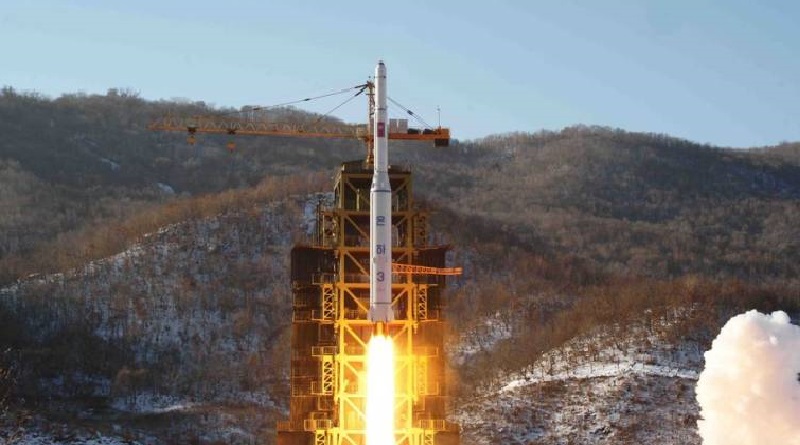North Korea gears up for Orbital Space Launch
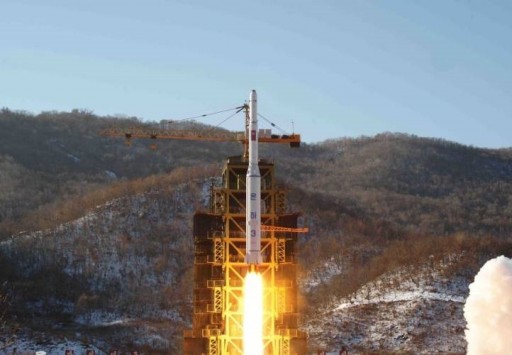
North Korea has confirmed plans of an orbital space launch to be conducted from the country’s Sohae Satellite Launching Station this month. Information of North Korea’s intentions of launching an Earth Observation Satellite was provided to UN agencies this week and navigational warnings for the impending launch were announced, specifying a launch window of February 8 through 25.
This is North Korea’s first orbital launch attempt since December 2012 when the Kwangmyongsong-3 satellite became the country’s first spacecraft to successfully reach orbit. The announcement of firm launch plans follows information published through U.S. intelligence services last week, indicating an increased level of activity at the Sohae launch base on the west coast of North Korea.
The announcement of North Korea’s intentions of conducting an orbital space launch led to strong international reactions as this launch attempt comes just over a month after the country’s fourth underground nuclear test conducted on January 6. North Korea claimed it had successfully tested a hydrogen bomb, though the consensus among international experts is that the test involved a fission bomb. Nevertheless, the test likely demonstrated a smaller nuclear device suitable for delivery via missile – placing the upcoming launch into a different light as it may be intended to demonstrate a long-rage delivery method for a nuclear bomb.
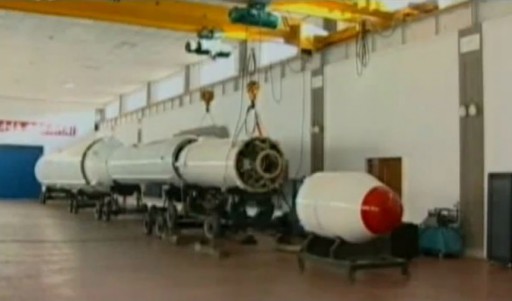
The demonstration of a miniaturized nuclear bomb and a long-range missile represent two of three critical components of a nuclear-capable ballistic missile system, the third being a re-entry vehicle of which there has yet to be a visible demonstration by North Korea.
North Korea has stressed that the upcoming launch will be of a peaceful nature in pursuit of technological and scientific endeavors – the same was noted for the 2012 launch. South Korea warned the north on Wednesday it would pay a ‘severe price’ if not abandoning the launch plans and Japan called up its military on high alert to shoot down any North Korean rocket entering its territory. The successful launch in 2012 was met with harsh criticism since it was seen as a clear violation of a 2006 UN Resolution banning North Korea from carrying out nuclear tests and launches of ballistic missiles.
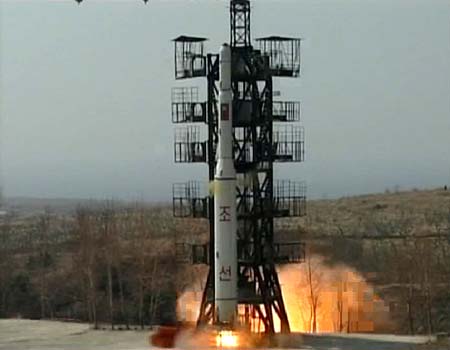
North Korea’s space aspirations date back to 1998 when the country carried out its first orbital launch attempt using a Paektusan rocket, an adaption of the Taepodong-1 intermediate-range missile that was outfitted with a third stage to conduct the orbital insertion of the 30-Kilogram Kwangmyongsong-1 satellite. Claims were made by the North Korean regime that the launch was a success, however, no objects were tracked in orbit and intelligence gathered by the United States pointed to a failure of the third stage.
The next launches carried out by North Korea used the more powerful Unha rocket, based on the Taepodong-2 ballistic missile. A test launch in July 2006 saw the rocket failing mid-flight when its first stage was still firing. Unha-2 launched with the Kwangmyongsong-2 satellite in 2009 and, despite claims to the contrary, failed to place the payload into orbit after what was later revealed to be a separation failure between the rocket’s second and third stages.
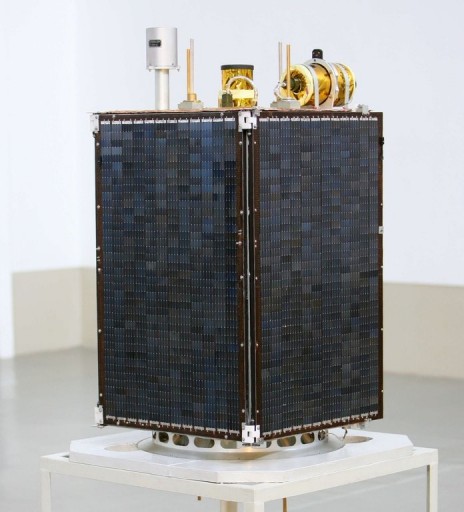
A rocket designated Unha-3 blasted off from Sohae in April 2012, carrying the 100-Kilogram Kwangmyongsong-3 satellite. The vehicle failed about 90 seconds into the flight when it broke apart according to radar data gathered by South Korea, showing the debris falling into the Yellow Sea. Coming back from this failure, North Korea essentially conducted a re-flight involving a rocket named Unha-3 Unit-2 and a satellite designated Kwangmyongsong-3-2, an identical copy of the first spacecraft, reportedly outfitted with an Earth observation camera and a radio payload.
Unha-3-2 lifted off on December 12, 2012 and headed straight to the south, aiming for a polar orbit. The launch was successful and delivered the satellite to an orbit of 494 by 588 Kilometers inclined 97.4 degrees with three additional objects, presumably the third stage and adapters/debris, also entering orbit. After its successful launch, the KMS-3-2 satellite was observed to be tumbling and there never were any radio transmissions of patriotic songs as promised by North Korea. The lack of radio signals and no signs of activity by the satellite suggested that it was never functional after separating from the carrier rocket.
Following the successful 2012 launch, North Korea spent several years upgrading the Sohae launch site with satellite imagery showing the erection of new buildings, the modification of the launch tower and signs of launch vehicle testing activities. Reports emerged in 2015 that construction activities were complete and a launch was being prepared, though the mission apparently slipped to a future date given a lack of activity at the launch base in the closing months of the year. Satellite imagery showed increased activity at the launch site in January and was promptly followed by this week’s announcements from the DPRK.
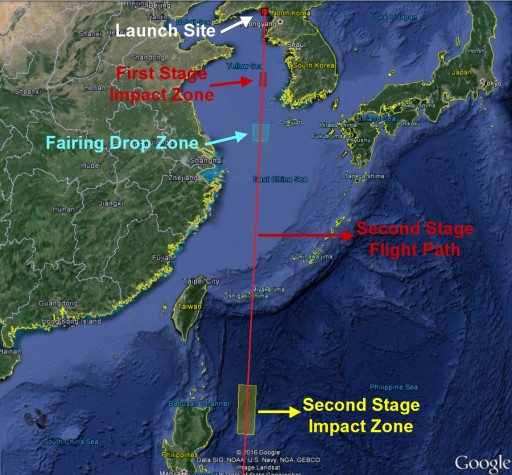
Information provided by North Korea specified the satellite designation as Kwangmyongsong, continuing in the line of previously launched spacecraft. The satellite is expected to operate for at least four years and fulfill an Earth Observation task.
No information on the identity of the launch vehicle has been provided, but navigational warnings place the drop zones of the first stage, payload fairing and second stage in the same locations identified for the April and December 2012 launches – confirming that the launch will use an Unha-3 launch vehicle.
The navigational warnings show the three impact zones for a nominal launch sequence taking the Unha rocket straight to the south from Sohae on North Korea’s west coast. The first stage is expected to impact 450 Kilometers downrange in the Yellow Sea, a little over 100 Kilometers from the South Korean coast line and 250km south west of Seoul.
The payload fairing, separated shortly into the burn of the second stage, will fall 750km from the launch site in the East China Sea, 100km from the small Island of Jejudo. The flight path has been designed to place the second stage impact zone over a remote area of the Philippine Sea, away from populated land masses and fishing areas. In order to reach a sun-synchronous orbit, the third stage will be responsible for an inclination adjustment, taking the launcher further west to increase the inclination to over 97°. A direct flight towards the target inclination would place the second stage impact area over the Philippines.
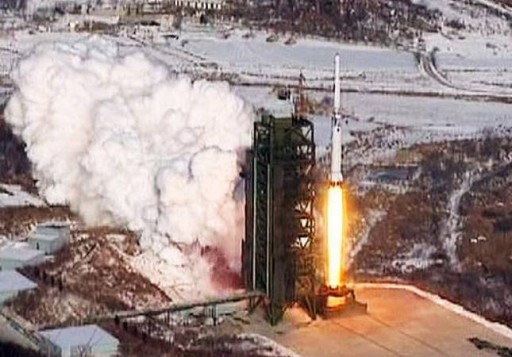
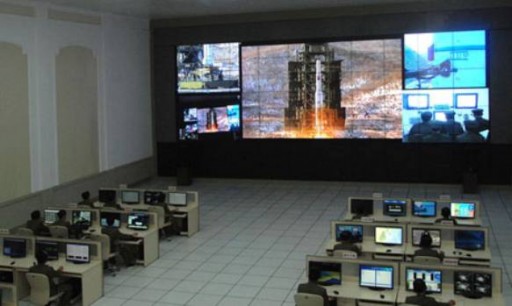
Unha (=Galaxy) is a three-stage carrier rocket based on the Taepodong-2 Ballistic Missile. The vehicle has a launch mass of approximately 90 metric tons and stands about 32 meters tall, capable of delivering around 100 Kilograms to orbit.
The first stage of the rocket measures 2.4 meters in diameter and has an estimated length of 15 meters. It is powered by a cluster of four Nodong motors which are scaled up versions of the Soviet Scud design giving the Unha rocket a total launch thrust of around 1,200 Kilonewtons.
The first stage was reportedly using Unsymmetrical Dimethylhydrazine as fuel and Nitric Acid as oxidizer, however, debris recovered after the December 2012 launch indicated a different propellant combination of Kerosene fuel and Inhibited Red Fuming Nitric Acid as oxidizer. Total propellant mass on the first stage is estimated around 60 metric tons.
Control during first stage flight is provided by four 30kN vernier engines with a +/-36° gimbal, contrary to previous reports that showed the first stage to be stabilized through the use of jet vanes.
Unha’s first stage fires for approximately two minutes and uses separation rockets to retreat from the second stage which has a smaller diameter of 1.5 meters, capable of holding up to 15 metric tons of propellants. It has an estimated length of 9.3 meters.
The propellant combination is unknown, though the second stage is likely using the same propellants as the first stage. Depending on whether the second stage is launched with a full propellant load, it can burn between three and four and a half minutes, generating a vacuum thrust of 150 Kilonewtons with a pair of turbopump-fed Scud/Nodong-class engines.
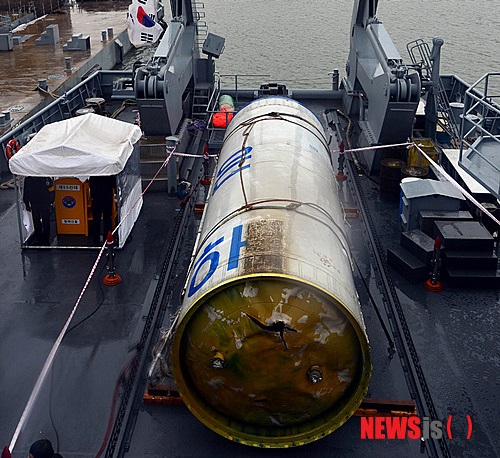
In the initial Unha design flown in 2009, the third stage was reported to be a solid rocket motor with a burn time of 40 seconds to complete the orbital insertion. It is understood that the first Unha-3 introduced a liquid-fueled stage using storable propellants and a pair of engines to deliver a total thrust in excess of one metric-ton force. The third stage has an estimated length of 3.7 meter and diameter of 1.2 meters, holding around three metric tons of propellant consumed in a burn of over three minutes. Spacecraft separation occurs nine and a half minutes after launch.
Details on the Kwangmyongsong satellite to be launched this month are not available, though it can be assumed that its design is similar to KMS-3-2 which carried an Earth observation camera and a 470MHz UHF radio payload to transmit patriotic songs. KMS-3-2 was reported to be three-axis stabilized and its cameras were to be used to collect still imagery as well as videos, to be downlinked via X-Band.

